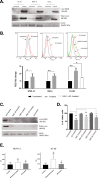The natural alkaloid Jerantinine B has activity in acute myeloid leukemia cells through a mechanism involving c-Jun
- PMID: 32635894
- PMCID: PMC7341637
- DOI: 10.1186/s12885-020-07119-2
The natural alkaloid Jerantinine B has activity in acute myeloid leukemia cells through a mechanism involving c-Jun
Abstract
Background: Acute myeloid leukemia (AML) is a heterogenous hematological malignancy with poor long-term survival. New drugs which improve the outcome of AML patients are urgently required. In this work, the activity and mechanism of action of the cytotoxic indole alkaloid Jerantinine B (JB), was examined in AML cells.
Methods: We used a combination of proliferation and apoptosis assays to assess the effect of JB on AML cell lines and patient samples, with BH3 profiling being performed to identify early effects of the drug (4 h). Phosphokinase arrays were adopted to identify potential driver proteins in the cellular response to JB, the results of which were confirmed and extended using western blotting and inhibitor assays and measuring levels of reactive oxygen species.
Results: AML cell growth was significantly impaired following JB exposure in a dose-dependent manner; potent colony inhibition of primary patient cells was also observed. An apoptotic mode of death was demonstrated using Annexin V and upregulation of apoptotic biomarkers (active caspase 3 and cleaved PARP). Using BH3 profiling, JB was shown to prime cells to apoptosis at an early time point (4 h) and phospho-kinase arrays demonstrated this to be associated with a strong upregulation and activation of both total and phosphorylated c-Jun (S63). The mechanism of c-Jun activation was probed and significant induction of reactive oxygen species (ROS) was demonstrated which resulted in an increase in the DNA damage response marker γH2AX. This was further verified by the loss of JB-induced C-Jun activation and maintenance of cell viability when using the ROS scavenger N-acetyl-L-cysteine (NAC).
Conclusions: This work provides the first evidence of cytotoxicity of JB against AML cells and identifies ROS-induced c-Jun activation as the major mechanism of action.
Keywords: Acute myeloid leukemia; Jerantinine; c-Jun; reactive oxygen species.
Conflict of interest statement
The authors declare that they have no competing interests.
Figures





References
-
- Dohner H, Estey E, Grimwade D, Amadori S, Appelbaum FR, Buchner T, Dombret H, Ebert BL, Fenaux P, Larson RA, et al. Diagnosis and management of AML in adults: 2017 ELN recommendations from an international expert panel. Blood. 2017;129(4):424–447. doi: 10.1182/blood-2016-08-733196. - DOI - PMC - PubMed
MeSH terms
Substances
LinkOut - more resources
Full Text Sources
Medical
Research Materials
Miscellaneous

